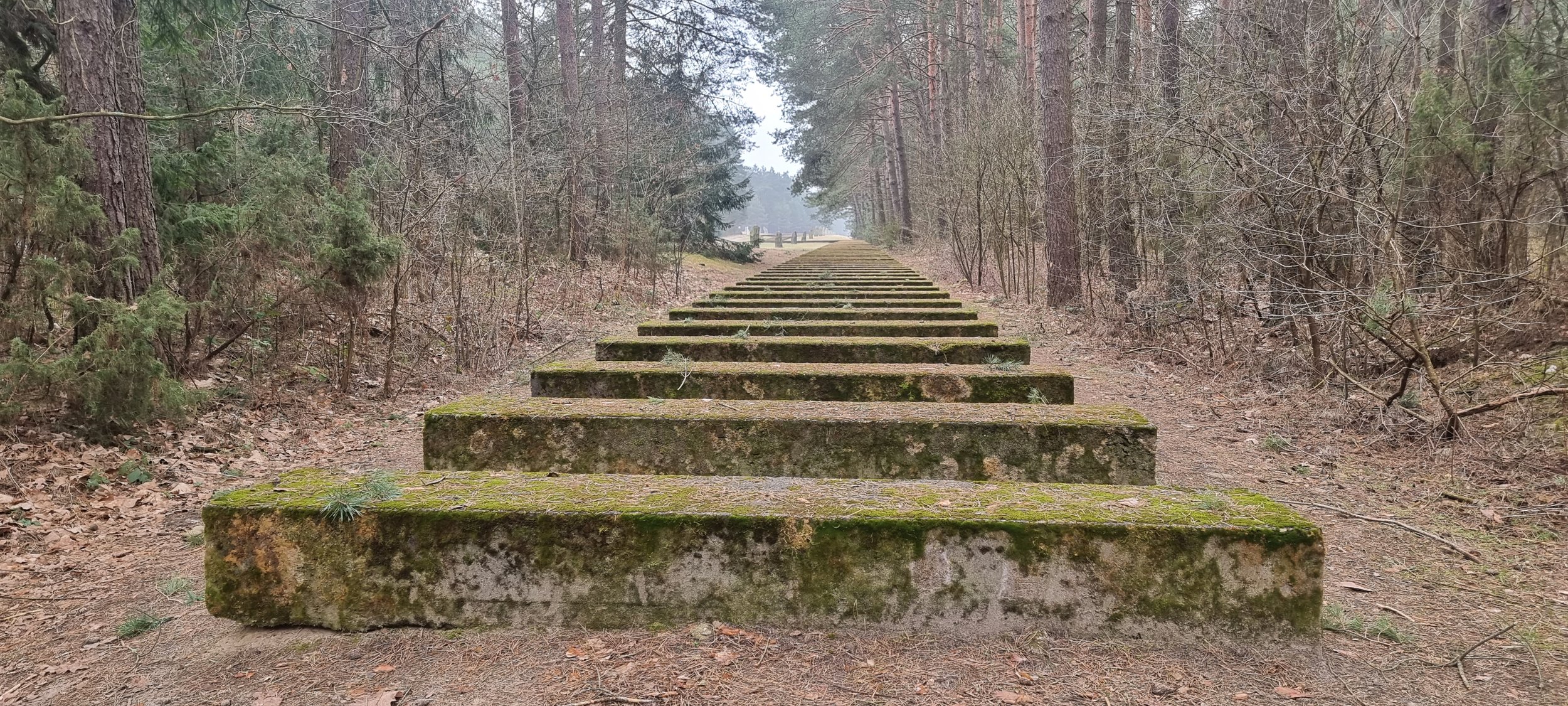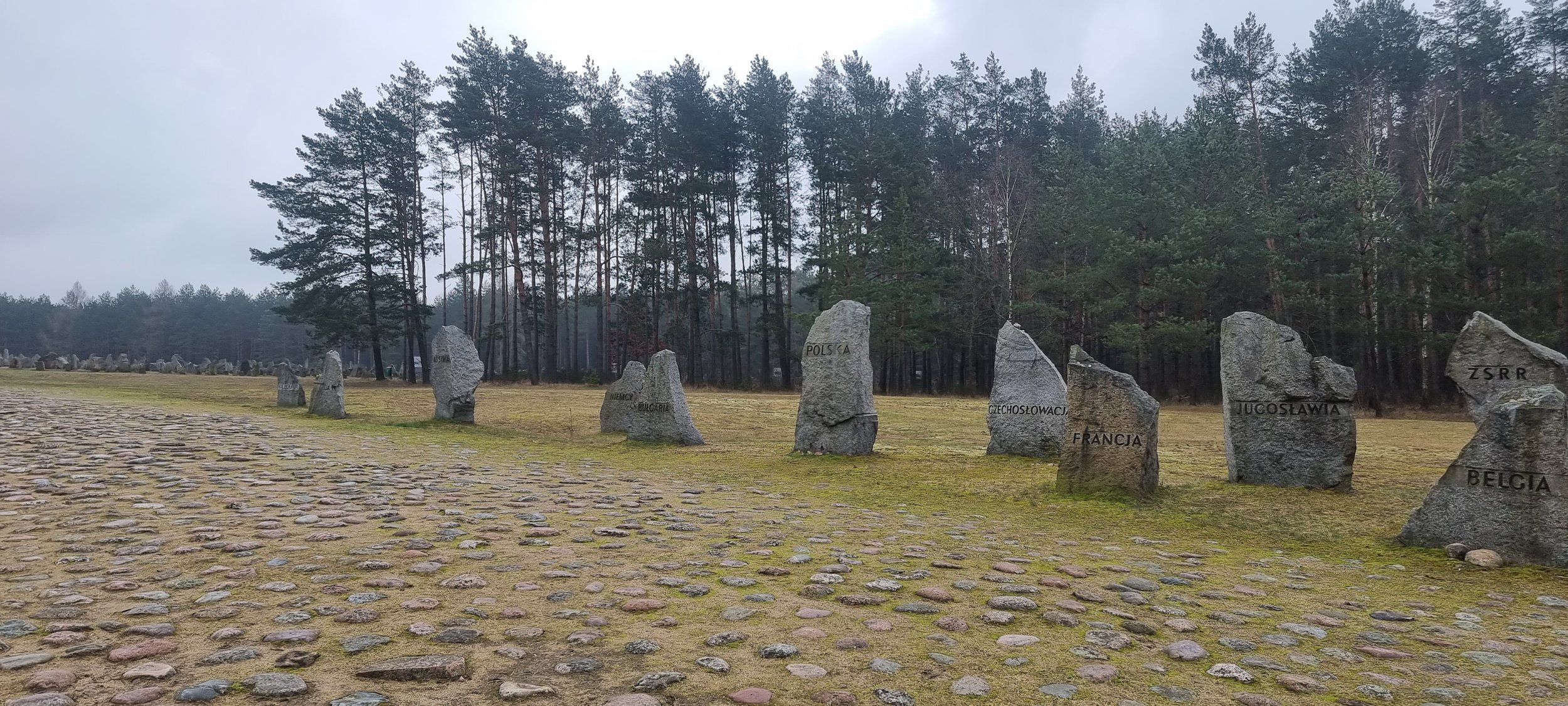
My Photos
Treblinka
This is not a happy place, it will not leave you feeling warm and fuzzy. There are various estimates of the total number of people killed at the Treblinka labor and extermination camp, however, most estimates suggest that between 700,000 to 900,000 Jewish people were killed here, making it only second to Auschwitz. There is a small museum at the site that explains the history of the camp. A selection of items found after the site was uncovered and a model of what the camp would have been like, but nothing can really prepare you for the scale of the place.
In the Museum building there is a permanent exhibition which presents the history of both camps – Treblinka II Extermination Camp and Treblinka I Penal Labour Camp. The exposition is complemented by exhibits discovered during archaeological research. The main element of the exhibition is a model of the Extermination Camp. The room is equipped with a TV set with educational films for museum visitors in Polish, English, Hebrew and German.
The Treblinka extermination camp (centre) was built by the Germans in mid-1942 next to a nearby penal labour camp. It was established as a part of Operation Reinhard, the goal of which was to eliminate the Jewish population. It covered an area of 17 hectares and was surrounded by a high barbed wire fence. The camp was operated by a command staff of 30-40 Germans and Austrians who were assisted by around 100-120 guards, mainly Ukrainians. Doctor of medicine Irmfried Eberl became the first command.
From 22 July 1942, announcements of the Jewish Council about the resettlement were put up on the walls of the ghetto houses in Warsaw, and every day a train with “displaced people”, known as a shuttle train, started to run between Warsaw and Treblinka. On 23 July 1942, in the morning hours, the first transport of Jews from Warsaw arrived at the camp, bringing 7,400 people. It consisted partly of residents of accommodation facilities for refugees and serving various penalties, mostly administrative ones, in the central prison at 24 Gęsia Street. On 23 July 1942, the first phase of murdering the people brought here began. It lasted until 28 August 1942.
The daily quota, initially set at 6,000 people, grew rapidly. According to the documents of the Jewish Council, 241,000 Jews were deported to Treblinka only from the Warsaw ghetto from the end of July to the middle of September 1942 during many displacement actions. Jews from other ghettos, such as Białystok, Grodno, Kielce, Radom, Łuków, Włoszczowa, Sędziszów, Szydłowiec, Kozienice, Częstochowa, Łochowa were also deported here. They were mainly Polish Jews from the General Government, brought here in freight wagons with barbed-wired windows. Those who tried to escape were shot.
The railroads Małkinia – Treblinka and Siedlce – Treblinka were covered with bodies. The guards fired at the escaping people, and the wounded were killed by German military policemen from the posts in Kosów Lacki and Bielany, sent deliberately to the vicinity of the railway tracks.
Another part of the camp consisted of the so-called reception area described by the Germans as Auffanglager – a transit camp. It consisted of a ramp, an undressing area for women and children where there was also a hairdresser, and the so-called cashier’s booths, i.e. a place where valuables were stored. On the opposite side there was a men’s undressing area. The undressing area was additionally fenced with barbed wire. From here, there was an arched road leading into the gas chambers called der Schlauch by the Germans, and by prisoners Himmelfahrtsstraße – the road of ascension or Himmelweg – the road to heaven.
The road to heaven. Fenced on both sides with barbed wire, it turned almost at right angles so that the influx of people into the gas chambers could be interrupted at the turn.
The first section of the Extermination Camp that you approach is Treblinka II, now a seemingly never-ending stone memorial to those who died. Some of the stones are engraved with the name of towns and villages that lost residents at the camp or notable people who died here, but most are blank. These stones stretch on and on and on. The eerie quiet that hangs over the camp truly brings home the scale of the atrocities that took place here.
At the ramp, there was a large barrack where the belongings of victims were sorted. This warehouse looked similarly to a railway station from the side of the ramp and tracks. There was a large sign “Ober Majdan”. The barrack had a fake ticket window and a fake clock painted on top. The hands pointed in the direction of the alleged change of trains to Białystok and Vawkavysk and in the direction of the bath house.
An important object was the so-called “lazarett”. It was not used for treatment, but on the contrary – for killing. Above the building there was a white flag with a red cross. Behind it there was a pit in which documents, photographs, diplomas and religious objects were burned. The sick, elderly, disabled, unaccompanied children and those who could delay the pace of “work” were led to the edge of this burning pit to be quickly killed. The people brought here were seated on a bench and killed with a shot to the back of their heads. Next to the lazaret there was a pit in which the bodies of those who died during transport were buried.
The only named Memorial stone -Henryk Goldszmit (1878 or 1879-1942), known under the pen name Janusz Korczak and the radio name Stary Doktor (“Old Doctor”), doctor by education and profession, writer by talent, educator and pedagogue by vocation and choice and, above all, an unusual precursor of children’s rights. He felt he belonged to the dual culture and nationality, as a Jew-Pole he was active in both communities, also to bring them closer together. Despite the chance to leave the ghetto, he remained with his orphans, whom he accompanied in their last journey, and was deported with them to the Treblinka extermination camp.
Janusz Korczak stone - The Germans occupied Poland in September 1939, and the Warsaw ghetto was established in November 1940. The orphanage was moved inside the ghetto. Korczak received many offers to be smuggled out of the ghetto, but he refused because he did not want to abandon the children. On August 5, 1942, Korczak joined nearly 200 children and orphanage staff members were rounded up for deportation to Treblinka, where they were all put to death.
The place where first three and later thirteen gas chambers stood, is built with a gigantic column with the menorah on it. The pit in which the corpses were cremated is depicted with a material that most closely resembles solidified tar.
Beyond the monument, lies the area where bodies were cremated, commemorated with a rectangle of melted black basalt. The third element consists of 17 thousand stones of varying sizes.
n the 1960s, Poland erected an impressive monument at Treblinka. Comprising 17,000 stones, it outlines the shape of the death camp. Concrete blocks resembling railroad ties mark the entrance to the camp where the railroad cars were brought in. A large stone arch marks the gas chamber, and a sunken, blackened stone sculpture marks the site where the bodies were burned.
Recent work in forensic cremation demonstrates that total eradication of bone requires extremely high temperatures. In most crematoria today, bones remain intact and have to be ground down to produce ash. At Treblinka it is clear that the ash contains many bones. Bone fragments can still be seen on the surface of the ground, especially after rain. I saw many, many bone fragments brought to the surface by excavations and moles during my visit in 2023. Considerable evidence also exists to suggest that not all of the bodies were exhumed and cremated. Photographs show bodies littering the landscape as late as the early 1960s. But this work is just the beginning and further work is required to understand the complexity of the site.
"The Treblinka Memorial attracts and repels at the same time. The stones don’t welcome you but there’s a magnetism found in the kinetic energy jutting and breaking from the ground reminding you, constantly reminding you of a world, a place you don’t want to live in, and yet you’re pulled to it, experiencing and remembering. And when you do leave you never forget the place – the stones – the experience of shards of jagged stones breaking from the ground and threatening you. Even on warm, summer days with a quiet forest surrounding all. And that too provides no relief because you know what happened there happened also on warm, beautiful, summer days. There was no escape, no relief. The Stones express that: no relief, no escape.” - Alan Metnick, author of photographs

















